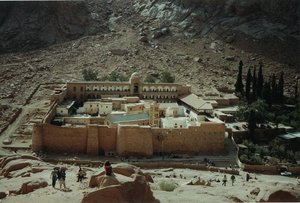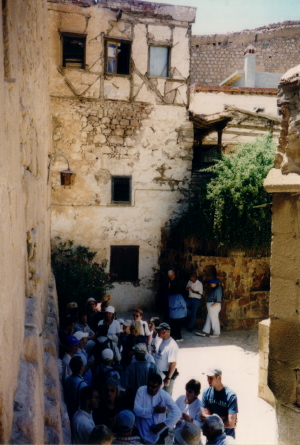Mănăstirea Sfânta Ecaterina (Sinai, Egipt)
| Acest articol (sau părți din el) este propus spre traducere din limba engleză!
Dacă doriți să vă asumați acestă traducere (parțial sau integral), anunțați acest lucru pe pagina de discuții a articolului. |
St. Catherine's Monastery is a monastery on the Sinai peninsula, at the foot of Mount Moses (Mount el-Deir) and Mount Sinai, in Egypt. It was built at the site where Moses is believed to have seen the Burning Bush, which is alive and on the grounds. Though it is commonly known as Saint Catherine's, the actual name of the monastery is the Monastery of the Transfiguration. It is sometimes also known as the Monastery of the Burning Bush. It is one of the oldest Christian monasteries in the world.
Cuprins
[ascunde]History
Originally founded by the Emperor St. Justinian the Great in 527, the monastery has weathered numerous changes in the history of the region, including the invasion of Islam, whose founder Mohammed himself guaranteed protection for the monastery. (The monastery still has possession of a written document from Mohammed to prove it.)

In the 9th century, the site was associated with St. Catherine of Alexandria (whose relics were miraculously transported there) and it became a favourite site for pilgrimages. Numerous ancient manuscripts have been preserved in the library, which is second only to the manuscript library of the Vatican. The collection consists of some 3,500 volumes in Greek, Coptic, Arabic, Armenian, Hebrew, Slavic, Syriac, Georgian and other languages.
A number of ancient icons are also on the grounds, including the famous Pantokrator of Sinai (7th c.), pictured at left, and The Ladder of Divine Ascent (12th c.), an iconic representation of the book by that name by St. John Climacus.
Architecture
The monastic church dates from the reign of St. Justinian. Its architect, Stephen of Aila, built a three-aisled, wood-roofed, basalt basilica, with carved capitals on the nave columns which are derived from the Corinthian order. The variation in the capitals there seem to be a deliberate choice, rather than the result of using columns from other buildings (which can be seen in other structures). The basilica has five side chapels, and towers flank the west end of the church. The sacred bush is left growing in the open beyond the east end of the building.
The monastery church has seen little essential change since the time of its imperial founder. Its great western portal is still closed by the original 1400 year old wooden door, which still functions perfectly on its first pins and hinges. The wood roof of the nave, also of 6th century construction, rests on beams that bear inscriptions honoring Justinian and his famous wife Theodora. These inscriptions had been reported by travelers as far back as the 18th century, but not until a 1958 expedition was a careful study made of them in relation to the church structure. The inscriptions mention "our most pious Emperor" Justinian and his "late Empress" Theodora. Theodora died in 548 and Justinian in 565, so that the church was completed between those years.
There are the remnants of a 10th or 11th century Fatimid mosque within the walls of the monastery, probably built to appease Muslim authorities of the time. Recent excavations within the mosque's walls have yielded evidence that the building predates its use as a mosque, however, as architectural and ornamental crosses and other Christian symbols have been found within.
There is also a small chapel called the Chapel of St. Tryphon which serves as an ossuary for the skulls of deceased monastics.
The Church of Sinai
The monastery, the nearby monastery at Raithu, and a handful of dependencies comprise the entire Church of Sinai, an autonomous Orthodox church headed by an archbishop, who is also the abbot of St. Catherine's. The archbishop is traditionally consecrated by the Patriarch of the Church of Jerusalem, though he is not the patriarch's subject.
The Burning Bush
In the Book of Exodus, Moses was forced to flee Egypt and came to live with Jethro. Moses, who shepherded Jethro's flocks, discovered the burning bush while tending the sheep.Moses approached the bush, and discovered that the bush was on fire, but the flames did not consume it. [Exodus 3:2] God's spirit, in the bush, then declared "I am your father's God, the God of Abraham, the God of Isaac, and the God of Jacob." [Exodus 3:4, NIV] God then commanded Moses to remove his sandals, as the land was considered holy.
God then ordered Moses to speak to Pharaoh, because He had "heard the people's cries". [Exodus 3:7] God promised that the Israelites, then enslaved by Pharaoh, would live in a land "flowing with milk and honey". [Exodus 3:9] When Moses expressed doubt that he would be believed, God gave Moses three "signs": his staff turned to a snake, his hand turned leprous (and was cured) and Moses was told that if they did not work, he would be able to turn water into blood. God then added that "He would be with him" (Moses), which finally encouraged him to demand the release of the Israelites.
Egeria, a 4th century pilgrim from Spain, had this to say about the site:
- "We had to advance deep into the valley for there are many hermit cells and a shrine at the site of the Bush. The Bush is verdant to this day. This is the Bush of which I have spoken earlier, the one from which God in a flame of fire spoke to Moses. The Bush is in a very beautiful garden in front of the Church." (see Egeria's Travels, ed. John Wilkinson (ISBN 0856687103)
The Chapel of the Burning Bush honors the Annunciation to the Holy Virgin. This is conveyed by "the Virgin of the Burning Bush," an icon that represents the Mother of God seated within the Burning Bush and holding her Son, with Moses worshiping barefooted on the left. A mosaic cross of the 10th century decorates the apse of the chapel.
The holy altar of the chapel stands not upon the sacred remains of martyrs, which is usual, but above the roots of the Burning Bush. The Bush flourishes several yards farther from he chapel where it was transplanted in order to build the Altar upon its roots. It is said that this is the only bush of its kind growing in the entire Sinai Peninsula, and that every attempt to transplant a branch of it to another place has been unsuccessful.
Pilgrims enter the chapel without shoes, in remembrance of the commandment of God to Moses, "Put off thy shoes from off thy feet, for the place whereon thou standest is holy ground."
Basilica of Transfiguration and liturgy
The Basilica of Holy Transfiguration of our Lord and Savior Jesus Christ is the biggest worship facility of this monastery and thus the center of its monastic life, where the liturgy is observed mainly. As built in the order of Emperor St. Justinian, the wooden doors of the sanctuary are called "Justinian Doors". Its apse is decorated with a huge mosaic of icon that represents Jesus Christ in his glorious transfiguration, accompanied by two prophets and three disciples. On its iconostasis, the royal door is not the place of the annunciation and it lacks four evangelists' representation either. Instead they accompany with the Theotokos on the left side of the door. The iconostasis includes also icons of martyrs, St. John the Forerunner with his beheaded head and St. Catherine of Alexandria attributed with a wheel whose relics are venerated within this basilica.
Pilgrims may join the liturgy, specially from 6 a.m., 9 a.m. and 5 p.m. The Divine Liturgy is held from 6 a.m. The language of liturgy is Greek.
Sources
- The Blackwell Dictionary of Eastern Christianity, p. 451
- Monastery of St. Catherine at Mount Sinai
- The Physical Components of the Monastery of Saint Catherine in the Sinai of Egypt by John Watson
- Wikipedia:Saint Catherine's Monastery, Mount Sinai
- Wikipedia:Burning Bush
More Images of St. Catherine's
External links
- Official Website of the Holy Monastery of St. Catherine at Mount Sinai
- Egypt Travel: St. Catherine's Monastery
- Links to St. Catherine's Monastery
- A lily in the wilderness - an article about the 1700th year anniversary celebration by Iason Athanasiadis
- Gallery of Photos of St. Catherines (CC licensed)
- Complete online text of Egeria's Travels
- Panographies








